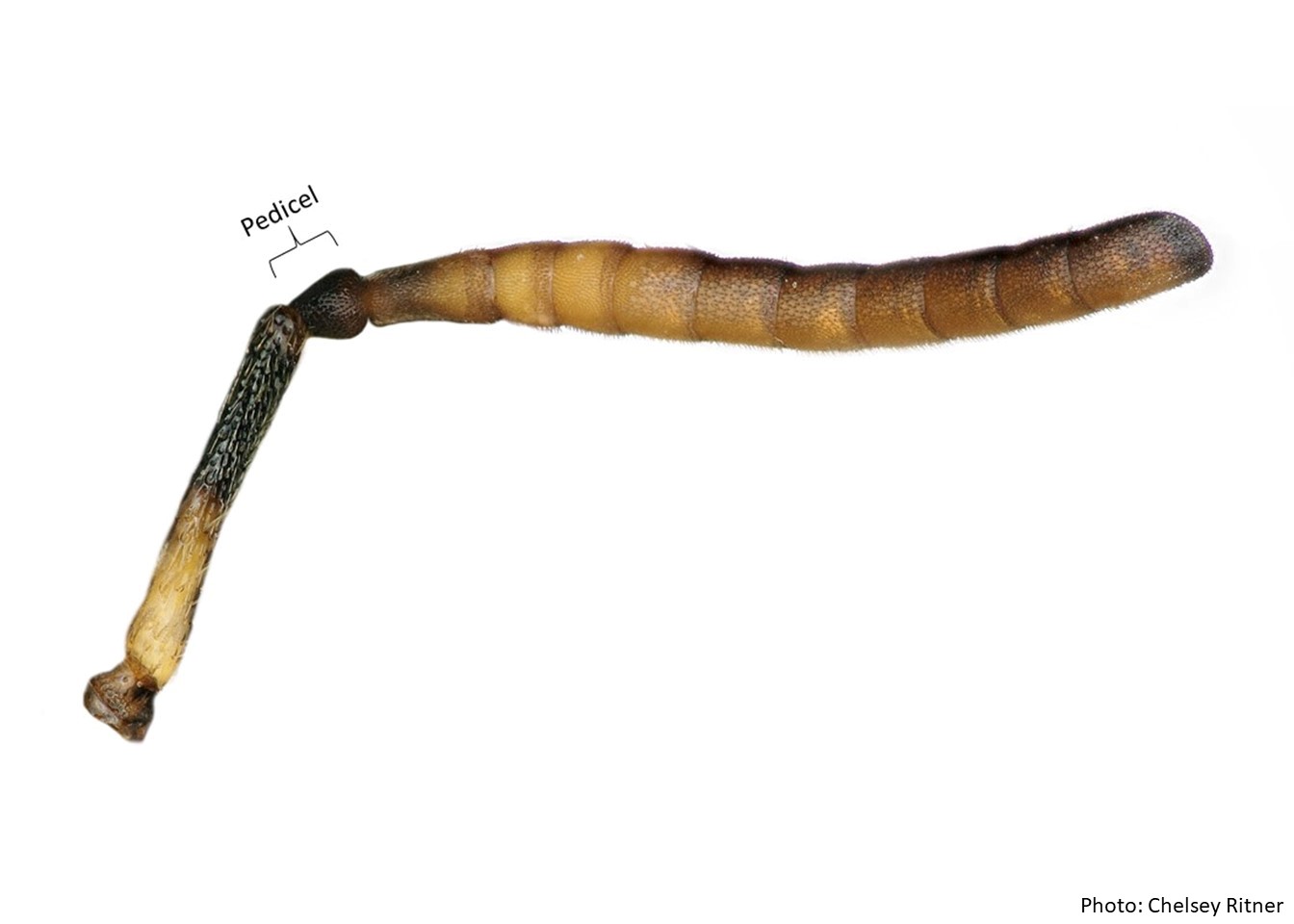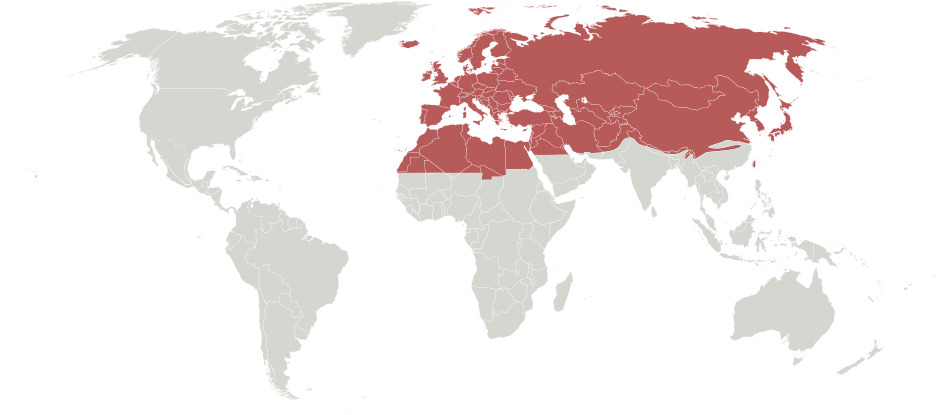Family: Megachilidae
Subfamily: Megachilinae
Tribe: Megachilini
Genus: Maximegachile Guiglia and Pasteels, 1961
Common name: none
Maximegachile are large, robust bees with black and white hairs (Michener 2007Michener 2007:
Michener, C.D. 2007. The Bees of the World (2nd ed.). Johns Hopkins University Press, Baltimore and London, 953 pp.). They range in body length from 14–25 mm (Michener 2007Michener 2007:
Michener, C.D. 2007. The Bees of the World (2nd ed.). Johns Hopkins University Press, Baltimore and London, 953 pp.). Maximegachile had previously been considered a subgenus of Megachile, but was elevated to genus status by Gonzalez et al. (2019).
(modified from Michener 2007Michener 2007:
Michener, C.D. 2007. The Bees of the World (2nd ed.). Johns Hopkins University Press, Baltimore and London, 953 pp.; Gonzalez 2008Gonzalez 2008:
Gonzalez, V.H. 2008. Phylogeny and classification of the bee tribe Megachilini (Hymenoptera: Apoidea: Megachilidae), with emphasis on the genus Megachile. Thesis: Department of Ecology and Evolutionary Biology and the College of Liberal Arts and Science of the University of Kansas: 1-274.; Praz 2017Praz 2017:
Praz, C.J. 2017. Subgeneric classification and biology of the leafcutter and dauber bees (genus Megachile Latreille) of the western Palearctic (Hymenoptera, Apoidea, Megachilidae). Journal of Hymenoptera Research 55: 1-54.)
 tapers to an apexapex:
tapers to an apexapex: .
. posterior margin with laterallateral:
posterior margin with laterallateral: preapicalpreapical:
preapicalpreapical:Maximegachile share a number of features with Stenomegachile. Females of both genera have long, shiny mandibles and a posterior tooth in the hypostomalhypostomal:
the notched region underneath the head and behind the mandible that holds the folded tongue
area. Males of both genera have a bilobed carinacarina:
a clearly defined ridge or keel, not necessarily high or acute; usually appears on bees as simply a raised line
and laterallateral:
relating, pertaining, or attached to the side
teeth on T6T6:
the segments on the top side of the abdomen, often abbreviated when referring to a specific segment to T1, T2, T3, T4, T5, T6, or T7 (Michener 2007Michener 2007:
(Michener 2007Michener 2007:
Michener, C.D. 2007. The Bees of the World (2nd ed.). Johns Hopkins University Press, Baltimore and London, 953 pp.). Unlike Stenomegachile, female Maximegachile have a three-toothed mandiblemandible:
bee teeth, so to speak, usually crossed and folded in front of the mouth (Michener 2007Michener 2007:
Michener, C.D. 2007. The Bees of the World (2nd ed.). Johns Hopkins University Press, Baltimore and London, 953 pp.). Male Maximegachile can be differentiated from Stenomegachile by their four-toothed mandiblemandible:
bee teeth, so to speak, usually crossed and folded in front of the mouth and the long, dense hair above the bilobed pre-apical carinacarina:
a clearly defined ridge or keel, not necessarily high or acute; usually appears on bees as simply a raised line
of T6T6:
the segments on the top side of the abdomen, often abbreviated when referring to a specific segment to T1, T2, T3, T4, T5, T6, or T7 (Michener 2007Michener 2007:
(Michener 2007Michener 2007:
Michener, C.D. 2007. The Bees of the World (2nd ed.). Johns Hopkins University Press, Baltimore and London, 953 pp.).
Maximegachile has been observed visiting Asteraceae, Amaranthaceae, and Fabaceae (Gess and Gess 2003Gess and Gess 2003:
Gess, S.K. and F.W. Gess. 2003. A catalogue of flower visiting records for aculeate wasps and bees in the semi-arid to arid areas of southern Africa. Albany Museum, Grahamstown, 529 pp.; Gous 2017Gous 2017:
Gous, A. 2017. Investigating floral choice in bees (Megachilidae) using pollen metabarcoding. University of KwaZulu-Natal [Doctoral dissertation].).
Maximegachile nest in pre-existing cavities and have been found in trap nests. They use sand and resin to construct their nests (Gess and Roosenschoon 2017Gess and Roosenschoon 2017:
Gess, S.K. and P.A. Roosenschoon. 2017. Notes on the nesting of three species of Megachilinae in the Dubai Desert Conservation Reserve, UAE. Journal of Hymenoptera Research 54: 43ndash;56.).
Maximegachile consists of two species: M. maxillosa and M. galactogagates (Penati and Mariotti 2015Penati and Mariotti 2015:
Penati, F. and A. Mariotti. 2015. Catalog of Hymenoptera described by Giovanni Gribodo (1846ndash;1924) (Insecta). Zootaxa 3929(1): 1-183.; Praz 2017Praz 2017:
Praz, C.J. 2017. Subgeneric classification and biology of the leafcutter and dauber bees (genus Megachile Latreille) of the western Palearctic (Hymenoptera, Apoidea, Megachilidae). Journal of Hymenoptera Research 55: 1-54.). Neither species are known to occur in the U.S. or Canada (Michener 2007Michener 2007:
Michener, C.D. 2007. The Bees of the World (2nd ed.). Johns Hopkins University Press, Baltimore and London, 953 pp.).
There are no known invasives.
Maximegachile are found in western Asia and Africa. They have been recorded in Israel and the United Arab Emirates in western Asia (Michener 2007Michener 2007:
Michener, C.D. 2007. The Bees of the World (2nd ed.). Johns Hopkins University Press, Baltimore and London, 953 pp.; Gess and Gess 2003Gess and Gess 2003:
Gess, S.K. and F.W. Gess. 2003. A catalogue of flower visiting records for aculeate wasps and bees in the semi-arid to arid areas of southern Africa. Albany Museum, Grahamstown, 529 pp.). In Africa, they are found from Senegal to South Africa and along the northeastern coast in Eritrea, Sudan, and Egypt (Michener 2007Michener 2007:
Michener, C.D. 2007. The Bees of the World (2nd ed.). Johns Hopkins University Press, Baltimore and London, 953 pp.; Gous 2017Gous 2017:
Gous, A. 2017. Investigating floral choice in bees (Megachilidae) using pollen metabarcoding. University of KwaZulu-Natal [Doctoral dissertation].).

Distribution map generated by Discover Life -- click on map for details, credits, and terms of use.
Gess, S.K. and F.W. Gess. 2003. A catalogue of flower visiting records for aculeate wasps and bees in the semi-arid to arid areas of southern Africa. Albany Museum, Grahamstown, 529 pp.
Gess, S.K. and P.A. Roosenchoon. 2017. Notes on the nesting of three species of Megachilinae in the Dubai Desert Conservation Reserve, UAE. Journal of Hymenoptera Research 54: 43-56.
Gonzalez, V.H. 2008. Phylogeny and classification of the bee tribe Megachilini (Hymenoptera: Apoidea: Megachilidae), with emphasis on the genus Megachile. Thesis: Department of Ecology and Evolutionary Biology and the College of Liberal Arts and Science of the University of Kansas: 1-274.
Gonzalez, V.H., G.T. Gustafson, and M.S. Engel. 2019. Morphological phylogeny of Megachilini and the evolution of leaf-cutter behavior in bees (Hymenoptera: Megachilidae). Journal of Melittology 85: 1-123.
Gous, A. 2017. Investigating floral choice in bees (Megachilidae) using pollen metabarcoding. University of KwaZulu-Natal [Doctoral dissertation].
Michener, C.D. 2007. The Bees of the World (2nd ed.). Johns Hopkins University Press, Baltimore and London, 953 pp.
Penati, F. and A. Mariotti. 2015. Catalog of Hymenoptera described by Giovanni Gribodo (1846–1924) (Insecta). Zootaxa 3929(1): 1-183.
Praz, C.J. 2017. Subgeneric classification and biology of the leafcutter and dauber bees (genus Megachile Latreille) of the western PalearcticPalearctic:
the largest biogeographic region; consists of Europe, Asia north of the Himalaya foothills, Northern Africa, and the northern and central parts of the Arabian Peninsula (Hymenoptera, Apoidea, Megachilidae). Journal of Hymenoptera Research 55: 1-54.
(Hymenoptera, Apoidea, Megachilidae). Journal of Hymenoptera Research 55: 1-54.